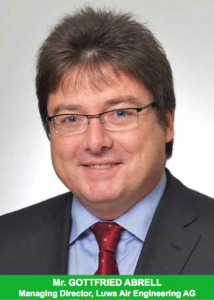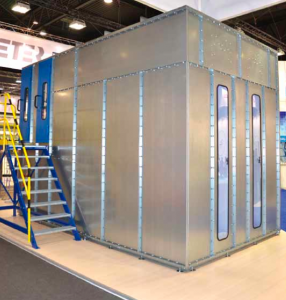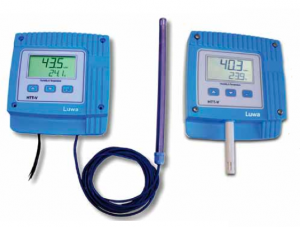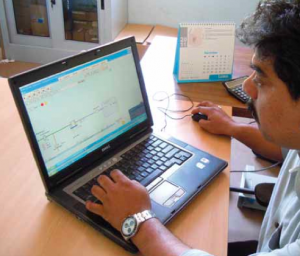By Gottfried Abrell, Managing Director, Luwa Air Engineering AG

In spinning and weaving factories, on an average 15 per cent of the energy, 8 per cent of the factory floor area and 8 per cent of the investment are for humidification and filtration systems. This is quite indispensable for the textile production process.
The question “Where can we save?” is obvious and is being asked by all factory owners and mill managers time and again. My answer may disappoint you that there is very little scope for further optimization or savings potential is left in the equipment cost. Our state-of-the-art equipment has gone through numerous optimization processes in the recent past and today has the best possible cost-benefit ratio. However this does not mean that there are no possibilities for future improvements (for example Luwa is developing a new space saving Multi CF Filter and ultra efficient axial flow fans). Nevertheless, there is a much bigger potential for improvements in the way new and existing plants are being operated.
Biggest saving potential
The question “Where can we save?” therefore has the wrong emphasis and should be formulated as “How can we manage to get the best result from this plant?”
About 15 per cent of the total energy in a spinning or weaving plant is used to recirculate huge air volumes with the aim to create the optimal environment for the textile production process. We also know from our experience what happens when the humidification plant is switched off – the production breaks down. This means at one extreme, where there is exactly maintained room conditions (for example 48 per cent relative humidity in the case of Comfor Spinning and say 80 per cent in the case of weaving), the production machines will achieve the highest possible efficiency.
 And on the other extreme where there is badly designed and functioning humidification systems the production efficiency will drop by 2 per cent to 5 per cent. Now, as you have observed that this is the crucial point; and here we have to work on making the system more efficient and thereby elevating the production efficiency to the highest level.
And on the other extreme where there is badly designed and functioning humidification systems the production efficiency will drop by 2 per cent to 5 per cent. Now, as you have observed that this is the crucial point; and here we have to work on making the system more efficient and thereby elevating the production efficiency to the highest level.
Undetected losses of performance
What is the normal working situation in most factories? Humidification systems are part of the utilities and as such are not under the direct control of the production manager – this is totally different from the textile production machines. For utilities corrective action will be taken only after serious deficiencies appear. This needs scrutinizing because the range of operation “not working optimally but undetected” is often neglected. Only when the production suffers will the management react.
In addition, it is difficult to quantify the problem because of the very narrow tolerances involved (± 2.5 per cent relative humidity). The unsatisfactory performance of an office building air-conditioning system is easily detected when the room conditions become uncomfortable. On the contrary, it is difficult to judge the relative humidity for a production machine, whether the relative humidity is 10 per cent higher or lower then the optimum. But for the textile production machine this deviation would result in a production loss of 2 to 5 per cent.
Just to briefly summarize, we are facing the following challenges:
- Air and its properties are invisible. The performance of the humidification plant must be visualized for the plant operator.
- The relative humidity can only be established through exact measurements
- Plants that operate in the range of “not working properly but undetected”
- The performance of the humidification plant is often not under the control of the production manager.
 Luwa has been dealing with these challenges for some time and has designed its products such that the performance of the humidification plant can be monitored in an easy and efficient way.
Luwa has been dealing with these challenges for some time and has designed its products such that the performance of the humidification plant can be monitored in an easy and efficient way.
- Each sensor has a digital display of the measured values
- Display and storage of the measured values on the computer
- Remote access to the DigiControl computer via the internet for service and updates
- Calibration set for the humidity sensors
- Big LED display in the production area
The LED displays are readable from far and enable the management and all the operators to monitor the air-conditioning performance.
“Preventive maintenance”
The comprehensive performance monitoring of the humidification system will cause changes in the maintenance procedures. Instead of “breakdown maintenance” which is being activated whenever an emergency arises, a “preventive maintenance” attitude will emerge and will become more and more significant because only in that way maintenance can be actively and professionally managed to achieve the desired results.
 The spare parts management system has to be looked into in the same context. How often do we encounter a situation where cheap non-genuine spare parts were purchased which have to be replaced after only a short period of time? The result: Costly plant stoppages and unnecessary waste of precious time.
The spare parts management system has to be looked into in the same context. How often do we encounter a situation where cheap non-genuine spare parts were purchased which have to be replaced after only a short period of time? The result: Costly plant stoppages and unnecessary waste of precious time.
It does not cost much more to buy genuine spare parts and keep an adequate stock to ensure a properly functioning humidification plant, with a smaller maintenance team than running to do fire fighting under the scenario “breakdown maintenance”.
You will agree that it is definitely worth operating a humidification system differently than it is normally done. Substantial savings can be achieved with higher productivity and reduced maintenance staff.
Finally we would like to point out that the changes must come from within the textile mills and it should not be left as the task of the humidification supplier. The humidification supplier must facilitate good maintenance by designing and supplying systems that provide all information necessary to attain 100 per cent plant performance.